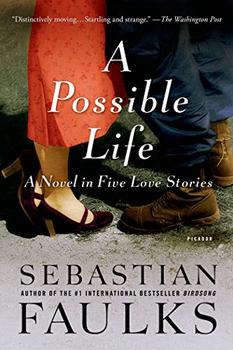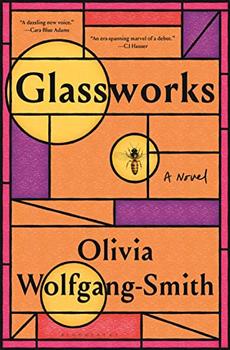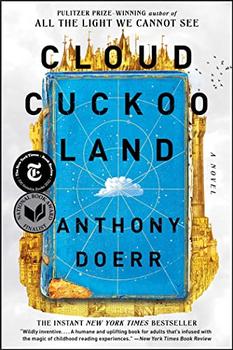Summary | Excerpt | Reading Guide | Reviews | Beyond the book | Read-Alikes | Genres & Themes | Author Bio

Critics' Opinion:
Readers' Opinion:
First Published:
Dec 2012, 304 pages
Paperback:
Nov 2013, 304 pages
 Book Reviewed by:
Book Reviewed by:
Elena Spagnolie
Buy This Book
Have you ever thought about how remarkably different people's lives are - that an intricate arrangement of choices, chance meetings, unforeseen circumstances, and relationships can combine to create a unique life path? Or, on the other hand, have you ever marveled over the universal sameness of the human experience? In A Possible Life: A Novel in Five Parts, Sebastian Faulks explores these seemingly contradictory yet complimentary ideas through five main characters, living in five different places, during five different time periods.
First, there's Geoffrey (1938), a young and naïve schoolteacher who enlists during WWII ("…there would be, he imagined, an intense but brief struggle in Europe") only to find himself in Nazi-occupied Poland in an unspeakable situation; Billy (1859), an industrious Englishman who works his way out of poverty and gets caught in a love triangle; Elena (2029), an Italian scientist whose ground-breaking work in the field of human consciousness doesn't seem to eliminate her loneliness; Jeanne (1822), a simple-minded French servant who comes to know God and embraces change; and Anya (1971), an American, Joplin-esque musician whose talent and thirst for freedom send her on a glorious yet self-destructive path.
Each of these carefully crafted stories is interesting in its own right. Faulks creates believable characters formed by their varied, personal histories, and he gives readers an understanding of the scope and context of their entire lives – from childhood through old age, and in some cases, death. The backdrop and atmospheric feel of each story is unique too. For example, Faulks's descriptions of England, France, and Eastern Europe during WWII are palpably different from the futuristic world of Italy circa 2035 (which, I was startled to realize, is not that far-off from today). He changes his language and narrative techniques to fit the time period and the personalities of his characters. Jack, the first-person narrator of Anya's story, is a record producer during the 1970s in New York; you can virtually smell the cigarette smoke on his breath as he sighs for her. But it takes an omniscient narrator to tell Jeanne's story, to describe how this unsophisticated French housekeeper is impacted by the power of the God.
And all the while, as these stories mark themselves as distinct entities, they simultaneously resemble one another. Through these same characters, Faulks exposes the shared and unchanging nature of humans' emotional needs. With great aplomb, he is able to highlight the collective human experience without making his characters feel like caricatures of each other. For example, Elena's childhood isolation, her refusal to make friends and her quiet days watching her father build boats feel similar to Billy's loneliness after being sent to a workhouse by his parents, too poor to keep him. While their lives and circumstances are completely different, they both ache for the attention of their fathers.
The genius of this book, however, is not simply in the quality of the individual stories or how they resemble one another; it's how Faulks is able to delicately stitch them together into a larger, more magnificent whole. In a brief interview the author comments on the book's structure: "There are little bits of connection between the five sections; but it's really going to be a bit like listening to a symphony in five movements or, if you like, an LP, an album, a CD in which the tracks are separate, but the whole thing adds up to more than the sum of its parts." (This reference is especially highlighted in Anya's story, as her songs are thoughtfully arranged to create her record.)
Unlike some novels that attempt this style, Faulks doesn't refashion the same plotline only to dress it up in period costumes, and much to his credit, he doesn't weigh down his stories with forced meaning. Instead, he takes a more organic look at how generations and eras seem to have actually affected each other – how they overlap, how memory fades while objects remain. He acknowledges the importance of our precious, personal experiences but also recognizes that we're all a part of the bigger, spinning world. While our lives are the most important things to us, ultimately, they're lost to history. Therefore our legacies aren't so much about what we've done, but rather, what we've shared with everyone else and how we've contributed to the lasting human experience. In this way, his book allows for a deeper message and reveals a more thorough understanding of life and humanity via his ability to zoom out and see the larger picture.
At times, I found myself unfamiliar with Faulks's more European references (e.g. the details of Geoffrey's "under eleven" cricket matches, some dialog written in French), but they certainly didn't detract from my experience of the book, they just gave it a distinctly European feel. (Side note: for more information on cricket, visit BookBrowse's "Beyond the Book" feature of Netherland.)
I recommend A Possible Life to anyone fascinated by how unique humans are and yet how we're all connected, to anyone who appreciates a well-put-together record album, and to anyone who likes a shift in literary perspective. Faulks's characters are so interesting, and the details of their interwoven lives so subtle, it's definitely worth a second or third read.
![]() This review was originally published in The BookBrowse Review in February 2013, and has been updated for the
November 2013 edition.
Click here to go to this issue.
This review was originally published in The BookBrowse Review in February 2013, and has been updated for the
November 2013 edition.
Click here to go to this issue.

If you liked A Possible Life, try these:

by Olivia Wolfgang-Smith
Published 2023
A gorgeously written and irresistibly intimate queer novel that follows one family across four generations to explore legacy and identity in all its forms.

by Anthony Doerr
Published 2022
From the Pulitzer Prize-winning author of All the Light We Cannot See, perhaps the most bestselling and beloved literary fiction of our time, comes a triumph of imagination and compassion, a soaring novel about children on the cusp of adulthood in a broken world, who find resilience, hope, and story.





The Flower Sisters
by Michelle Collins Anderson
From the new Fannie Flagg of the Ozarks, a richly-woven story of family, forgiveness, and reinvention.

The House on Biscayne Bay
by Chanel Cleeton
As death stalks a gothic mansion in Miami, the lives of two women intertwine as the past and present collide.

The Funeral Cryer by Wenyan Lu
Debut novelist Wenyan Lu brings us this witty yet profound story about one woman's midlife reawakening in contemporary rural China.
Your guide toexceptional books
BookBrowse seeks out and recommends the best in contemporary fiction and nonfiction—books that not only engage and entertain but also deepen our understanding of ourselves and the world around us.